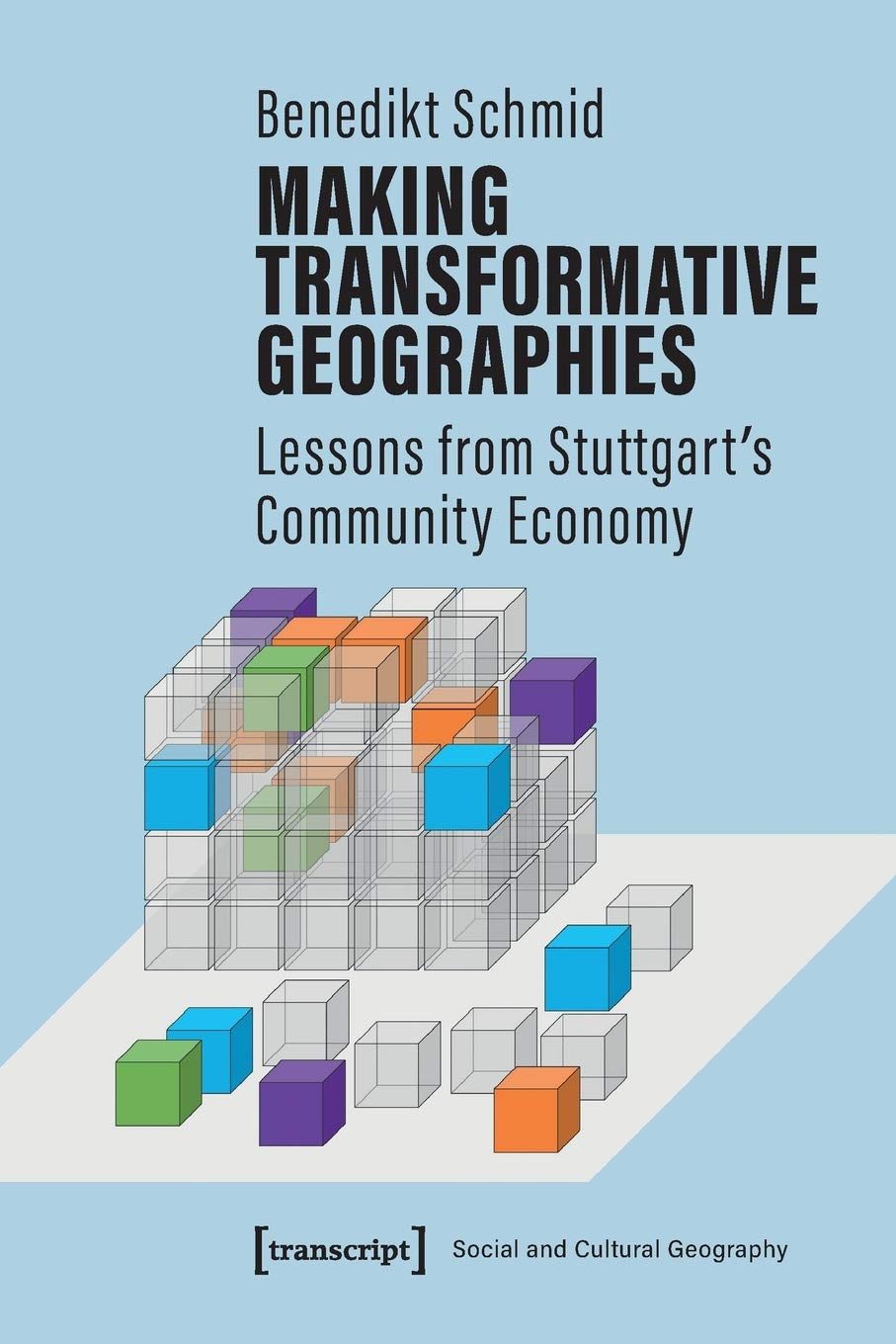In the face of climate change and growing inequality, people are coming together to create economic spaces which are not organized around the extractive logics of capitalism. In Making Transformative Geographies, Benedikt Schmid draws on community economies scholarship and practice theory to understand how such alternatives can be channeled into a degrowth transition.
Making Transformative Geographies centers around the author’s exploratory qualitative research of 24 ecosocial organizations in Stuttgart, Germany. These include for-profit groups such as Slowtec, a company which produces sustainable technology, through to nonprofits and community groups like Foodsharing, a group that organizes against food waste. Rather than arbitrating between “good” and “bad’ approaches, Schmid’s aim is to understand the social, spatial and strategic dimensions of transformation and to ask what strategies can be employed for a degrowth transition.
The book is divided into five parts, the first of which reviews the literature on capitalism and alternative economies. The author begins by tracing the relationship between capitalism and the structural need for growth. Rather than arguing about the magnitude of change needed or the possibility of such a change, Schmid is concerned with problematizing the growth paradigm and introducing its alternatives. In doing so, he deftly distinguishes between alterity and diversity, transition and transformation, and different “agents” of change. Schmid focuses on post-capitalism and degrowth as strands of scholarship which are both rooted in a critique of capitalist relations. The literature review concludes by introducing a spatial perspective, understanding that transformation includes a “politics of place” (Gibson-Graham, 2006, p. xxiv). Following Jessop et al. (2008), Schmid uses territory, network, place and scale to theorize the spatial relationships of transformation.
The second part of the book provides the conceptual scaffolding of the research. Schmid positions his research as speaking to the critique of the “epistemic fallacy” (Castree, 1999, p. 145) of community economies scholarship: that it confuses the world with our thinking about it, suggesting that we can imagine our way out of capitalism. Schmid introduces practice theory as a means of materializing community economies by focusing on the institutions and power relations that constrain or enable transformative practices. He does this by separating out the social dimensions of transformation: economy, governance, communality, subjectivity and technology. Schmid gives examples of how social change toward degrowth involves changing logics in each of these spheres.
Yet in enacting sustainability related practices, organizations employ different strategies and make compromises that can resist, reproduce or shift existing alignments. Schmid draws on Wright’s (2010) forms of transformation in distinguishing between three strategies of transformation, (1) symbiotic: increasing possibilities for emancipation and addressing social issues without tackling capitalism head on, (2) interstitial: the building of alternatives in niches within margins of capitalist society, or (3) ruptural: confronting capitalist institutions head on, a sharp break with existing structures. In bringing together these spatial, social and strategic dimensions, Schmid demonstrates the complexity of transformation. For example, an organization’s economic practices could be ruptural, but their logic of subjectivity could reproduce capitalist competitiveness. Some may operate through networks, and others may be place-based. This conceptualization not only acts as a tool for analyzing degrowth projects, but highlights possibilities for strategic organizing.
Part three outlines the research methodology. Schmid provides comprehensive detail, including his coding framework, which may be useful to those starting out in researching alternative economies. Then, part four presents the author’s findings, outlining the alternative practices of the 24 organizations before turning to the factors that constrain degrowth transition, and the institutional arrangements that enable it. Here, Schmid uncovers the compromises that are made in, and the tactics of, the organizations in navigating transformative geographies.
Part five offers a reflection of these findings and their implications beyond Stuttgart. Schmid considers what constitutes degrowth practices and organizations, before focusing on the socio-spatial strategies of degrowth that he considers to be most promising: (1) networked interstitial strategies for economic transformation, (2) territorial ruptural strategies for transformation in governance, and (3) place-based symbiotic strategies for transformations in communality.
Although Making Transformative Geographies contributes to our understanding of the complex geographies of transformation by locating viable coordinates for transformation, Schmid’s focus is largely on material constraints such as the dependence on for-profit models and the lack of legal structures for nonhierarchical organizing. Less attention is given to the role of power and subjectivity as barriers or enablers of degrowth transitions. Given recent work such as Morrow and Martin (2019), which showed that the capacity to engage with alternatives is unevenly distributed, with black and brown people facing greater surveillance, and Diprose (2014) who found that only certain people were seen as legitimately enacting alternatives, the question remains of the role of ruptural, symbiotic and interstitial strategies in just degrowth transformation.
Moreover, the sense of place that is so core to Schmid’s argument takes second place to his theoretical focus. The color and vividness of Stuttgart as a city and the organizations featured at times feel like an afterthought. Whilst part four gives some space to transcripts and descriptions of the organizations in question, overall there is little space for these to live and breathe.
Regardless, Making Transformative Geographies makes a valuable empirical and conceptual contribution to geographical thought on degrowth transitions. It treads the fine line between understanding the constraints to transformation and preserving the imaginative space of alternatives. Beyond his overarching arguments, Schmid steers the reader through questions about the role of technology in degrowth transition, how to balance the modalities of antagonism and imagination, and how transformation is rooted in temporal and spatial context. For geographers and non-geographers alike, Making Transformative Geographies is a useful guide for navigating the nuances of the literature on economic transformation and a hopeful starting point for alternative organizing.
